Mabo v Queensland (No 2) Case: Analysis of Native Title in Australia
VerifiedAdded on 2020/03/16
|10
|2044
|246
Report
AI Summary
This report provides a comprehensive analysis of the Mabo v Queensland (No 2) case, a landmark decision in Australian legal history concerning native title. It begins with an introduction to the case, highlighting the doctrine of terra nullius and its impact on Aboriginal and Torres Strait Islander peoples. The report outlines the facts of the case, the issue of land rights, and the court's judgment, which overturned terra nullius and recognized native title. It then explores the impact of the Mabo decision, including the passage of the Native Title Act 1993, and addresses the shortcomings of the current legislative system, such as proving ongoing connection to the land, issues with mining corporations, overlapping of native titles, and the lengthy process of claims. Finally, the report discusses the uncertain future of native title and the need for improved regulations to protect the rights of Indigenous peoples. The report concludes that while the Mabo case was a significant step towards recognizing native title, further reforms are necessary to ensure that Indigenous communities can fully exercise their rights.
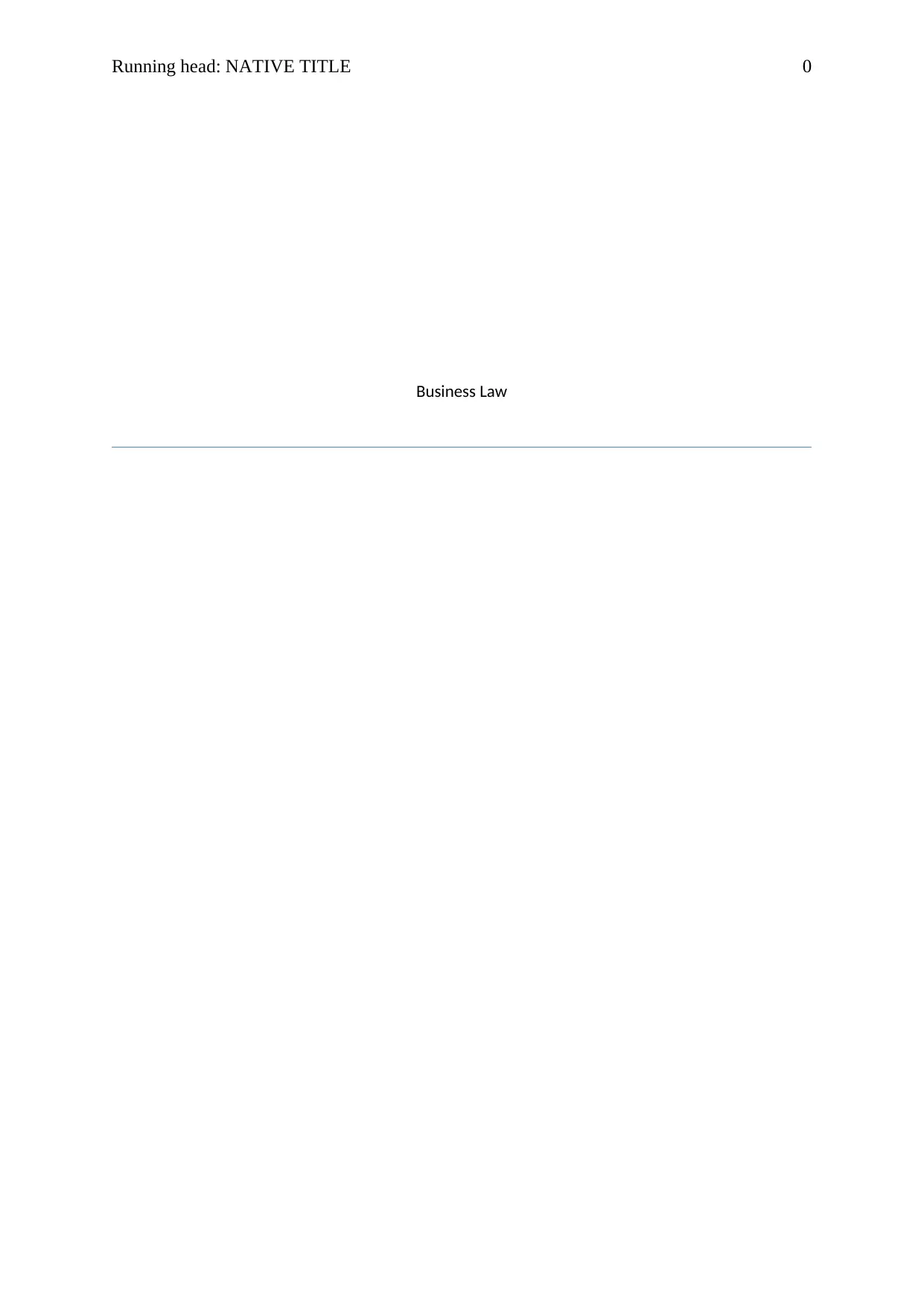
Running head: NATIVE TITLE 0
Business Law
Business Law
Paraphrase This Document
Need a fresh take? Get an instant paraphrase of this document with our AI Paraphraser
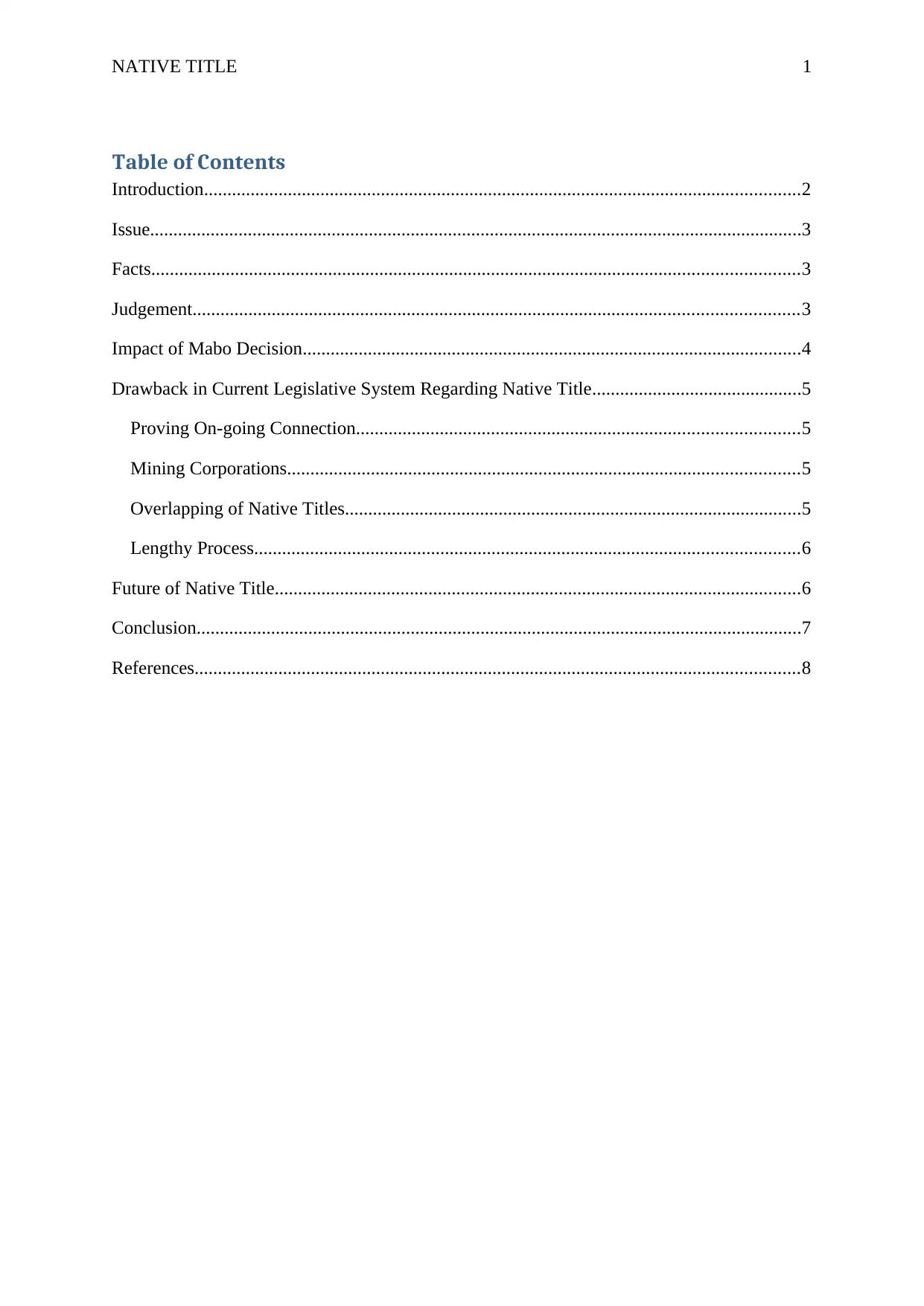
NATIVE TITLE 1
Table of Contents
Introduction................................................................................................................................2
Issue............................................................................................................................................3
Facts...........................................................................................................................................3
Judgement..................................................................................................................................3
Impact of Mabo Decision...........................................................................................................4
Drawback in Current Legislative System Regarding Native Title.............................................5
Proving On-going Connection...............................................................................................5
Mining Corporations..............................................................................................................5
Overlapping of Native Titles..................................................................................................5
Lengthy Process.....................................................................................................................6
Future of Native Title.................................................................................................................6
Conclusion..................................................................................................................................7
References..................................................................................................................................8
Table of Contents
Introduction................................................................................................................................2
Issue............................................................................................................................................3
Facts...........................................................................................................................................3
Judgement..................................................................................................................................3
Impact of Mabo Decision...........................................................................................................4
Drawback in Current Legislative System Regarding Native Title.............................................5
Proving On-going Connection...............................................................................................5
Mining Corporations..............................................................................................................5
Overlapping of Native Titles..................................................................................................5
Lengthy Process.....................................................................................................................6
Future of Native Title.................................................................................................................6
Conclusion..................................................................................................................................7
References..................................................................................................................................8
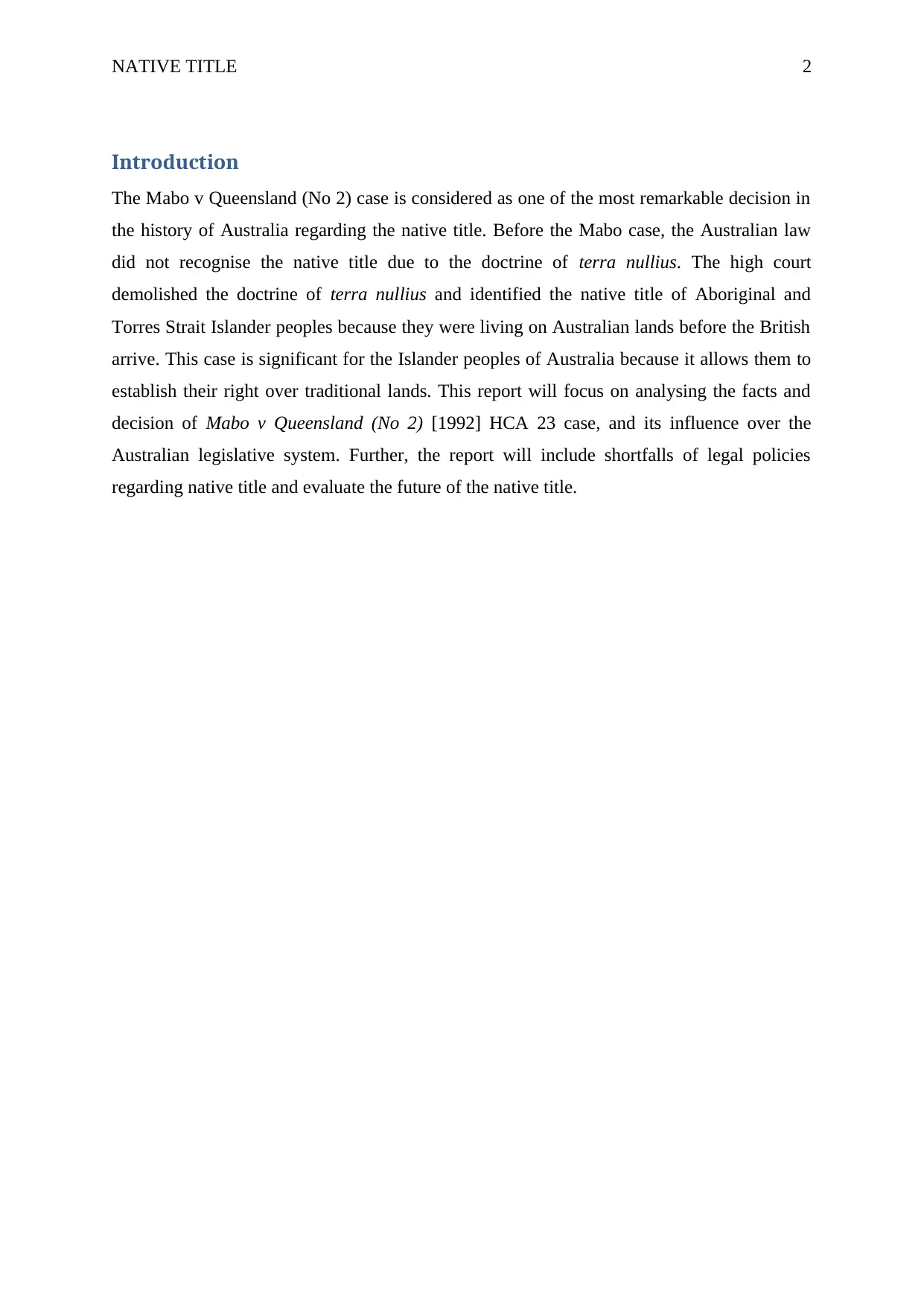
NATIVE TITLE 2
Introduction
The Mabo v Queensland (No 2) case is considered as one of the most remarkable decision in
the history of Australia regarding the native title. Before the Mabo case, the Australian law
did not recognise the native title due to the doctrine of terra nullius. The high court
demolished the doctrine of terra nullius and identified the native title of Aboriginal and
Torres Strait Islander peoples because they were living on Australian lands before the British
arrive. This case is significant for the Islander peoples of Australia because it allows them to
establish their right over traditional lands. This report will focus on analysing the facts and
decision of Mabo v Queensland (No 2) [1992] HCA 23 case, and its influence over the
Australian legislative system. Further, the report will include shortfalls of legal policies
regarding native title and evaluate the future of the native title.
Introduction
The Mabo v Queensland (No 2) case is considered as one of the most remarkable decision in
the history of Australia regarding the native title. Before the Mabo case, the Australian law
did not recognise the native title due to the doctrine of terra nullius. The high court
demolished the doctrine of terra nullius and identified the native title of Aboriginal and
Torres Strait Islander peoples because they were living on Australian lands before the British
arrive. This case is significant for the Islander peoples of Australia because it allows them to
establish their right over traditional lands. This report will focus on analysing the facts and
decision of Mabo v Queensland (No 2) [1992] HCA 23 case, and its influence over the
Australian legislative system. Further, the report will include shortfalls of legal policies
regarding native title and evaluate the future of the native title.
⊘ This is a preview!⊘
Do you want full access?
Subscribe today to unlock all pages.

Trusted by 1+ million students worldwide
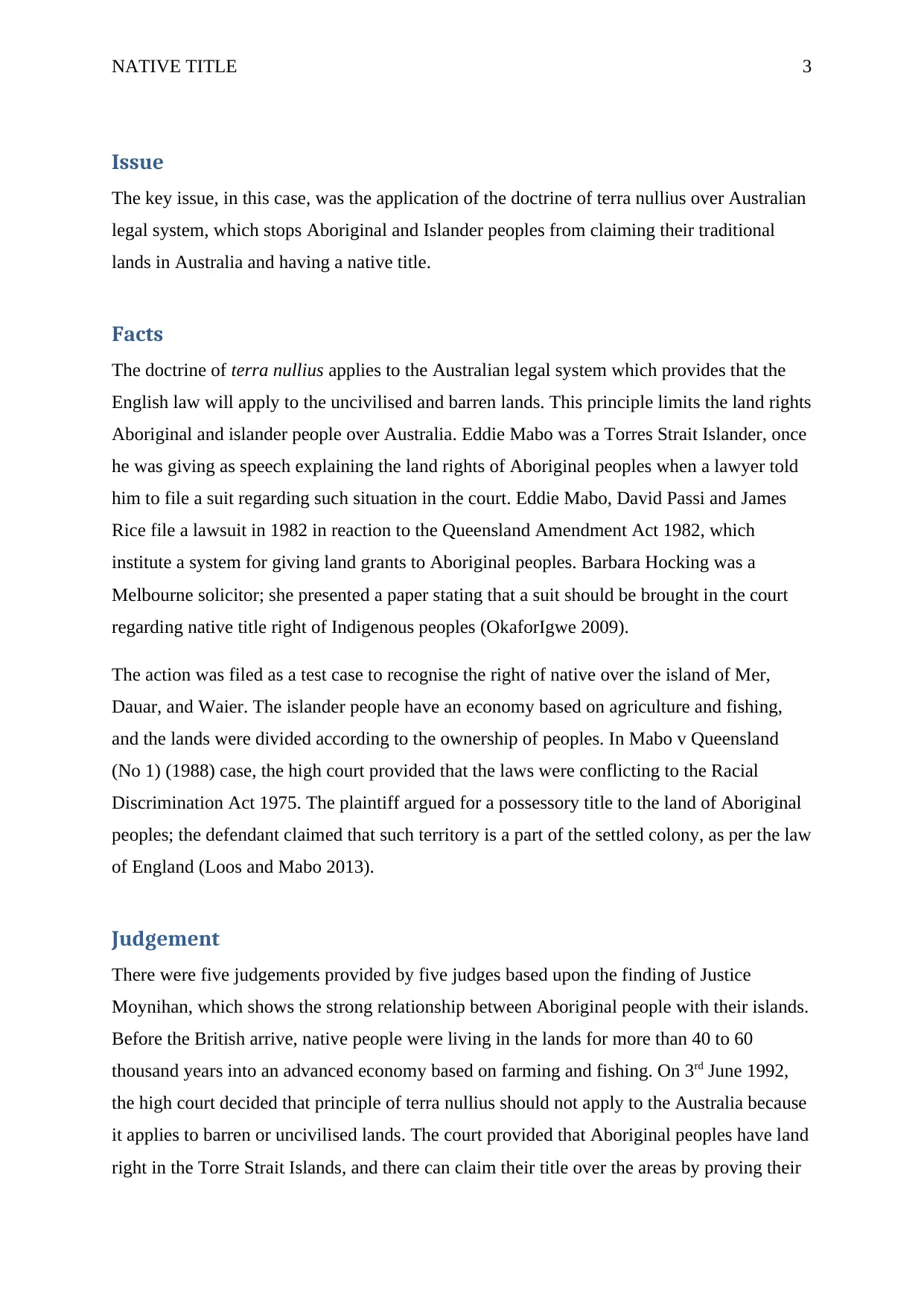
NATIVE TITLE 3
Issue
The key issue, in this case, was the application of the doctrine of terra nullius over Australian
legal system, which stops Aboriginal and Islander peoples from claiming their traditional
lands in Australia and having a native title.
Facts
The doctrine of terra nullius applies to the Australian legal system which provides that the
English law will apply to the uncivilised and barren lands. This principle limits the land rights
Aboriginal and islander people over Australia. Eddie Mabo was a Torres Strait Islander, once
he was giving as speech explaining the land rights of Aboriginal peoples when a lawyer told
him to file a suit regarding such situation in the court. Eddie Mabo, David Passi and James
Rice file a lawsuit in 1982 in reaction to the Queensland Amendment Act 1982, which
institute a system for giving land grants to Aboriginal peoples. Barbara Hocking was a
Melbourne solicitor; she presented a paper stating that a suit should be brought in the court
regarding native title right of Indigenous peoples (OkaforIgwe 2009).
The action was filed as a test case to recognise the right of native over the island of Mer,
Dauar, and Waier. The islander people have an economy based on agriculture and fishing,
and the lands were divided according to the ownership of peoples. In Mabo v Queensland
(No 1) (1988) case, the high court provided that the laws were conflicting to the Racial
Discrimination Act 1975. The plaintiff argued for a possessory title to the land of Aboriginal
peoples; the defendant claimed that such territory is a part of the settled colony, as per the law
of England (Loos and Mabo 2013).
Judgement
There were five judgements provided by five judges based upon the finding of Justice
Moynihan, which shows the strong relationship between Aboriginal people with their islands.
Before the British arrive, native people were living in the lands for more than 40 to 60
thousand years into an advanced economy based on farming and fishing. On 3rd June 1992,
the high court decided that principle of terra nullius should not apply to the Australia because
it applies to barren or uncivilised lands. The court provided that Aboriginal peoples have land
right in the Torre Strait Islands, and there can claim their title over the areas by proving their
Issue
The key issue, in this case, was the application of the doctrine of terra nullius over Australian
legal system, which stops Aboriginal and Islander peoples from claiming their traditional
lands in Australia and having a native title.
Facts
The doctrine of terra nullius applies to the Australian legal system which provides that the
English law will apply to the uncivilised and barren lands. This principle limits the land rights
Aboriginal and islander people over Australia. Eddie Mabo was a Torres Strait Islander, once
he was giving as speech explaining the land rights of Aboriginal peoples when a lawyer told
him to file a suit regarding such situation in the court. Eddie Mabo, David Passi and James
Rice file a lawsuit in 1982 in reaction to the Queensland Amendment Act 1982, which
institute a system for giving land grants to Aboriginal peoples. Barbara Hocking was a
Melbourne solicitor; she presented a paper stating that a suit should be brought in the court
regarding native title right of Indigenous peoples (OkaforIgwe 2009).
The action was filed as a test case to recognise the right of native over the island of Mer,
Dauar, and Waier. The islander people have an economy based on agriculture and fishing,
and the lands were divided according to the ownership of peoples. In Mabo v Queensland
(No 1) (1988) case, the high court provided that the laws were conflicting to the Racial
Discrimination Act 1975. The plaintiff argued for a possessory title to the land of Aboriginal
peoples; the defendant claimed that such territory is a part of the settled colony, as per the law
of England (Loos and Mabo 2013).
Judgement
There were five judgements provided by five judges based upon the finding of Justice
Moynihan, which shows the strong relationship between Aboriginal people with their islands.
Before the British arrive, native people were living in the lands for more than 40 to 60
thousand years into an advanced economy based on farming and fishing. On 3rd June 1992,
the high court decided that principle of terra nullius should not apply to the Australia because
it applies to barren or uncivilised lands. The court provided that Aboriginal peoples have land
right in the Torre Strait Islands, and there can claim their title over the areas by proving their
Paraphrase This Document
Need a fresh take? Get an instant paraphrase of this document with our AI Paraphraser
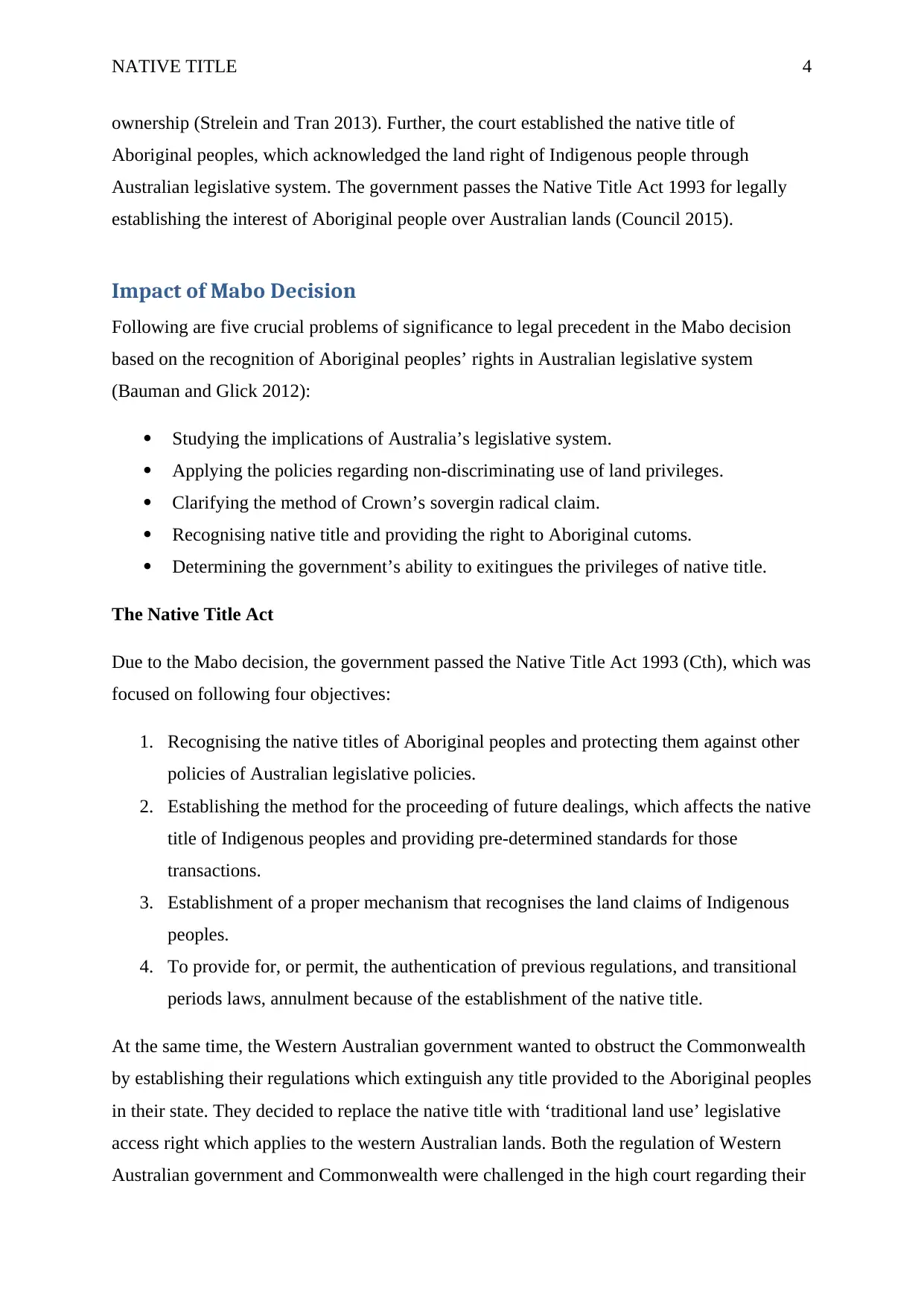
NATIVE TITLE 4
ownership (Strelein and Tran 2013). Further, the court established the native title of
Aboriginal peoples, which acknowledged the land right of Indigenous people through
Australian legislative system. The government passes the Native Title Act 1993 for legally
establishing the interest of Aboriginal people over Australian lands (Council 2015).
Impact of Mabo Decision
Following are five crucial problems of significance to legal precedent in the Mabo decision
based on the recognition of Aboriginal peoples’ rights in Australian legislative system
(Bauman and Glick 2012):
Studying the implications of Australia’s legislative system.
Applying the policies regarding non-discriminating use of land privileges.
Clarifying the method of Crown’s sovergin radical claim.
Recognising native title and providing the right to Aboriginal cutoms.
Determining the government’s ability to exitingues the privileges of native title.
The Native Title Act
Due to the Mabo decision, the government passed the Native Title Act 1993 (Cth), which was
focused on following four objectives:
1. Recognising the native titles of Aboriginal peoples and protecting them against other
policies of Australian legislative policies.
2. Establishing the method for the proceeding of future dealings, which affects the native
title of Indigenous peoples and providing pre-determined standards for those
transactions.
3. Establishment of a proper mechanism that recognises the land claims of Indigenous
peoples.
4. To provide for, or permit, the authentication of previous regulations, and transitional
periods laws, annulment because of the establishment of the native title.
At the same time, the Western Australian government wanted to obstruct the Commonwealth
by establishing their regulations which extinguish any title provided to the Aboriginal peoples
in their state. They decided to replace the native title with ‘traditional land use’ legislative
access right which applies to the western Australian lands. Both the regulation of Western
Australian government and Commonwealth were challenged in the high court regarding their
ownership (Strelein and Tran 2013). Further, the court established the native title of
Aboriginal peoples, which acknowledged the land right of Indigenous people through
Australian legislative system. The government passes the Native Title Act 1993 for legally
establishing the interest of Aboriginal people over Australian lands (Council 2015).
Impact of Mabo Decision
Following are five crucial problems of significance to legal precedent in the Mabo decision
based on the recognition of Aboriginal peoples’ rights in Australian legislative system
(Bauman and Glick 2012):
Studying the implications of Australia’s legislative system.
Applying the policies regarding non-discriminating use of land privileges.
Clarifying the method of Crown’s sovergin radical claim.
Recognising native title and providing the right to Aboriginal cutoms.
Determining the government’s ability to exitingues the privileges of native title.
The Native Title Act
Due to the Mabo decision, the government passed the Native Title Act 1993 (Cth), which was
focused on following four objectives:
1. Recognising the native titles of Aboriginal peoples and protecting them against other
policies of Australian legislative policies.
2. Establishing the method for the proceeding of future dealings, which affects the native
title of Indigenous peoples and providing pre-determined standards for those
transactions.
3. Establishment of a proper mechanism that recognises the land claims of Indigenous
peoples.
4. To provide for, or permit, the authentication of previous regulations, and transitional
periods laws, annulment because of the establishment of the native title.
At the same time, the Western Australian government wanted to obstruct the Commonwealth
by establishing their regulations which extinguish any title provided to the Aboriginal peoples
in their state. They decided to replace the native title with ‘traditional land use’ legislative
access right which applies to the western Australian lands. Both the regulation of Western
Australian government and Commonwealth were challenged in the high court regarding their
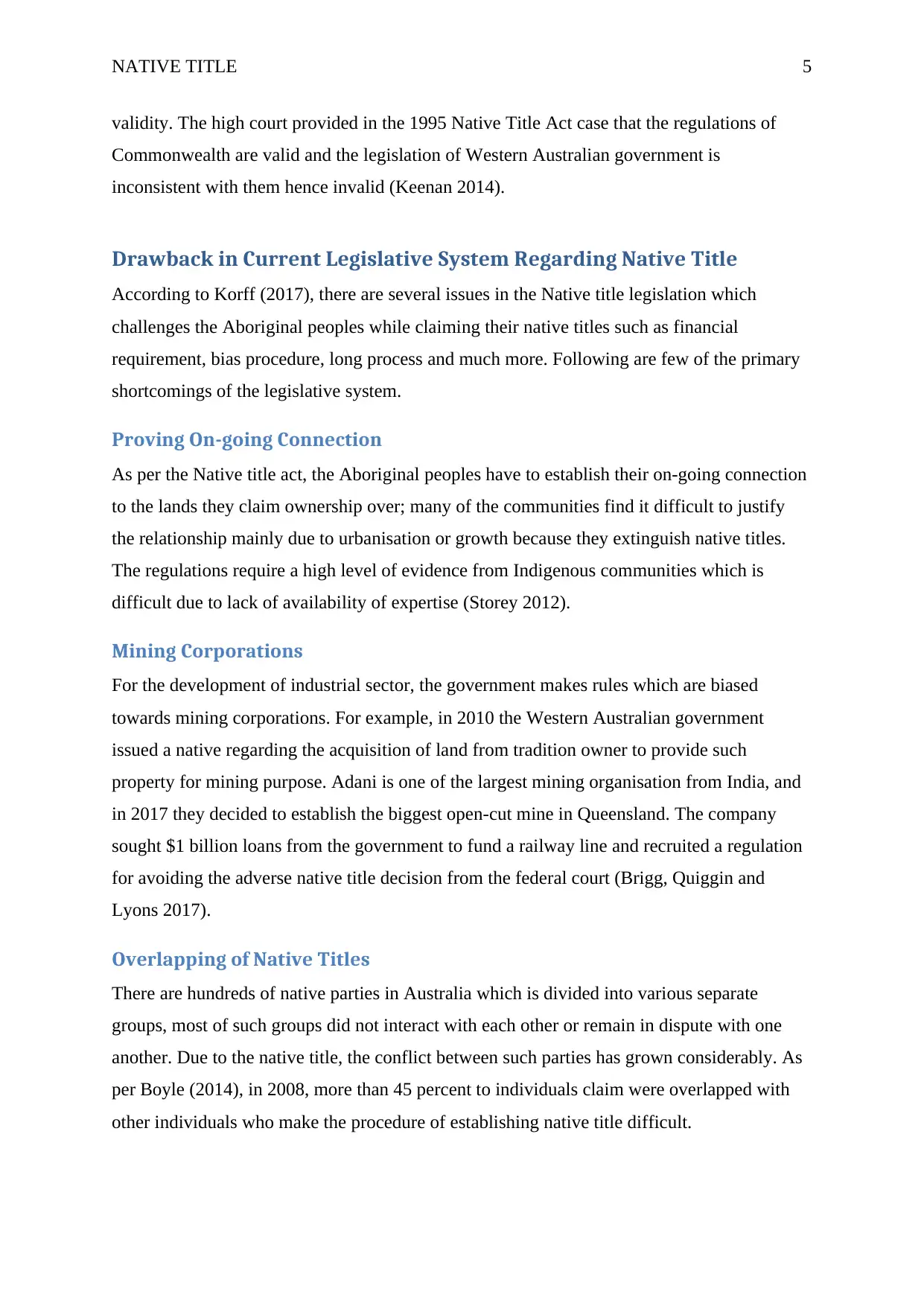
NATIVE TITLE 5
validity. The high court provided in the 1995 Native Title Act case that the regulations of
Commonwealth are valid and the legislation of Western Australian government is
inconsistent with them hence invalid (Keenan 2014).
Drawback in Current Legislative System Regarding Native Title
According to Korff (2017), there are several issues in the Native title legislation which
challenges the Aboriginal peoples while claiming their native titles such as financial
requirement, bias procedure, long process and much more. Following are few of the primary
shortcomings of the legislative system.
Proving On-going Connection
As per the Native title act, the Aboriginal peoples have to establish their on-going connection
to the lands they claim ownership over; many of the communities find it difficult to justify
the relationship mainly due to urbanisation or growth because they extinguish native titles.
The regulations require a high level of evidence from Indigenous communities which is
difficult due to lack of availability of expertise (Storey 2012).
Mining Corporations
For the development of industrial sector, the government makes rules which are biased
towards mining corporations. For example, in 2010 the Western Australian government
issued a native regarding the acquisition of land from tradition owner to provide such
property for mining purpose. Adani is one of the largest mining organisation from India, and
in 2017 they decided to establish the biggest open-cut mine in Queensland. The company
sought $1 billion loans from the government to fund a railway line and recruited a regulation
for avoiding the adverse native title decision from the federal court (Brigg, Quiggin and
Lyons 2017).
Overlapping of Native Titles
There are hundreds of native parties in Australia which is divided into various separate
groups, most of such groups did not interact with each other or remain in dispute with one
another. Due to the native title, the conflict between such parties has grown considerably. As
per Boyle (2014), in 2008, more than 45 percent to individuals claim were overlapped with
other individuals who make the procedure of establishing native title difficult.
validity. The high court provided in the 1995 Native Title Act case that the regulations of
Commonwealth are valid and the legislation of Western Australian government is
inconsistent with them hence invalid (Keenan 2014).
Drawback in Current Legislative System Regarding Native Title
According to Korff (2017), there are several issues in the Native title legislation which
challenges the Aboriginal peoples while claiming their native titles such as financial
requirement, bias procedure, long process and much more. Following are few of the primary
shortcomings of the legislative system.
Proving On-going Connection
As per the Native title act, the Aboriginal peoples have to establish their on-going connection
to the lands they claim ownership over; many of the communities find it difficult to justify
the relationship mainly due to urbanisation or growth because they extinguish native titles.
The regulations require a high level of evidence from Indigenous communities which is
difficult due to lack of availability of expertise (Storey 2012).
Mining Corporations
For the development of industrial sector, the government makes rules which are biased
towards mining corporations. For example, in 2010 the Western Australian government
issued a native regarding the acquisition of land from tradition owner to provide such
property for mining purpose. Adani is one of the largest mining organisation from India, and
in 2017 they decided to establish the biggest open-cut mine in Queensland. The company
sought $1 billion loans from the government to fund a railway line and recruited a regulation
for avoiding the adverse native title decision from the federal court (Brigg, Quiggin and
Lyons 2017).
Overlapping of Native Titles
There are hundreds of native parties in Australia which is divided into various separate
groups, most of such groups did not interact with each other or remain in dispute with one
another. Due to the native title, the conflict between such parties has grown considerably. As
per Boyle (2014), in 2008, more than 45 percent to individuals claim were overlapped with
other individuals who make the procedure of establishing native title difficult.
⊘ This is a preview!⊘
Do you want full access?
Subscribe today to unlock all pages.

Trusted by 1+ million students worldwide
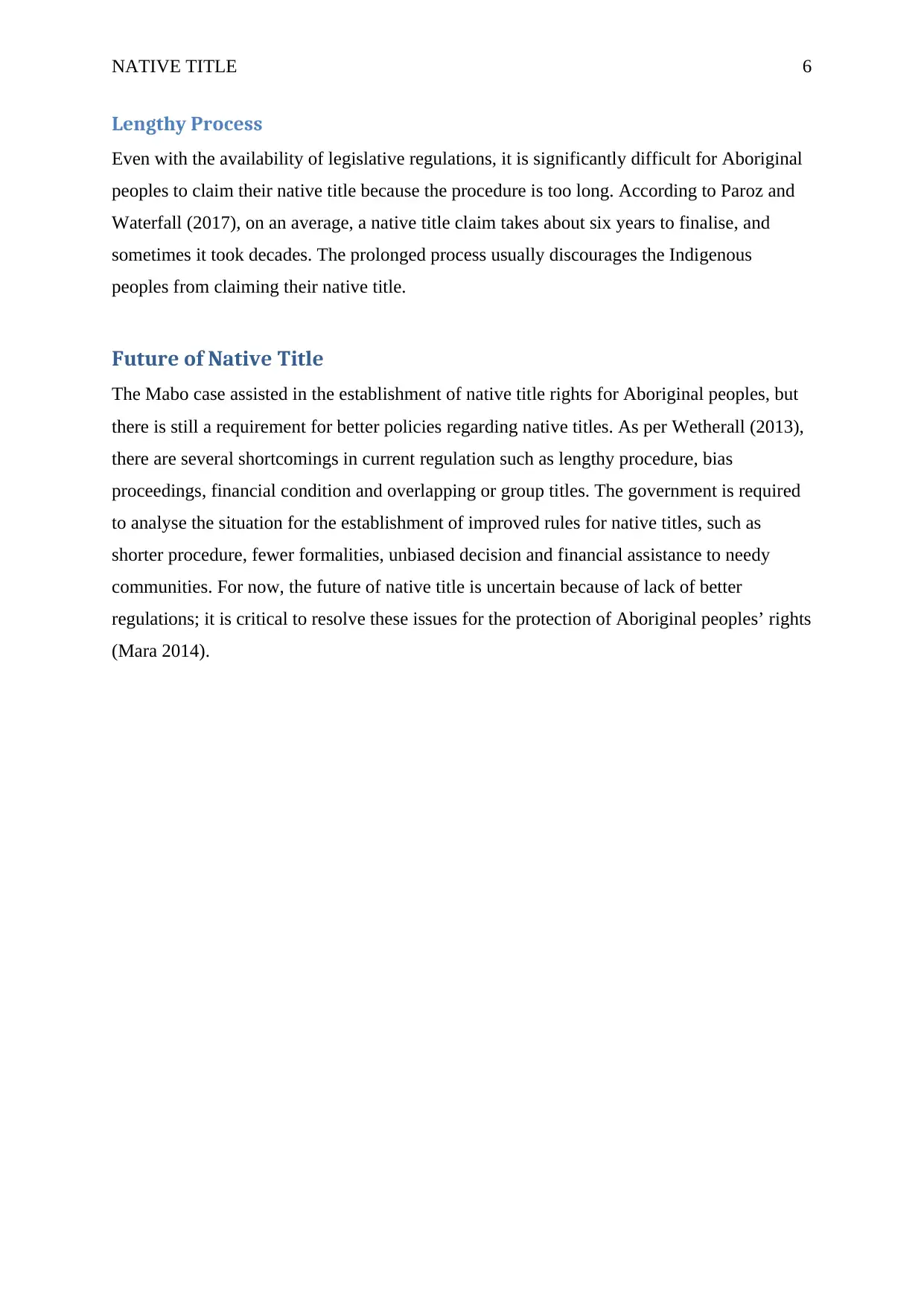
NATIVE TITLE 6
Lengthy Process
Even with the availability of legislative regulations, it is significantly difficult for Aboriginal
peoples to claim their native title because the procedure is too long. According to Paroz and
Waterfall (2017), on an average, a native title claim takes about six years to finalise, and
sometimes it took decades. The prolonged process usually discourages the Indigenous
peoples from claiming their native title.
Future of Native Title
The Mabo case assisted in the establishment of native title rights for Aboriginal peoples, but
there is still a requirement for better policies regarding native titles. As per Wetherall (2013),
there are several shortcomings in current regulation such as lengthy procedure, bias
proceedings, financial condition and overlapping or group titles. The government is required
to analyse the situation for the establishment of improved rules for native titles, such as
shorter procedure, fewer formalities, unbiased decision and financial assistance to needy
communities. For now, the future of native title is uncertain because of lack of better
regulations; it is critical to resolve these issues for the protection of Aboriginal peoples’ rights
(Mara 2014).
Lengthy Process
Even with the availability of legislative regulations, it is significantly difficult for Aboriginal
peoples to claim their native title because the procedure is too long. According to Paroz and
Waterfall (2017), on an average, a native title claim takes about six years to finalise, and
sometimes it took decades. The prolonged process usually discourages the Indigenous
peoples from claiming their native title.
Future of Native Title
The Mabo case assisted in the establishment of native title rights for Aboriginal peoples, but
there is still a requirement for better policies regarding native titles. As per Wetherall (2013),
there are several shortcomings in current regulation such as lengthy procedure, bias
proceedings, financial condition and overlapping or group titles. The government is required
to analyse the situation for the establishment of improved rules for native titles, such as
shorter procedure, fewer formalities, unbiased decision and financial assistance to needy
communities. For now, the future of native title is uncertain because of lack of better
regulations; it is critical to resolve these issues for the protection of Aboriginal peoples’ rights
(Mara 2014).
Paraphrase This Document
Need a fresh take? Get an instant paraphrase of this document with our AI Paraphraser

NATIVE TITLE 7
Conclusion
In conclusion, the Mabo case has significant influence over the recognition of native title
regulations in Australian legislative system. Due to the Mabo decision, the Native Act 1993
was passed which recognise the rights of Indigenous peoples. But, most of the Aboriginal
people are not being able to enjoy their rights due to the various shortcoming of the law. The
drawbacks of legislation include lengthy processes, the financial condition of communities,
biased judgements and a significant number of formalities. For better implementation of
native titles, it is necessary that government evaluate the situation and establish improved
regulations, until then the future of native title is uncertain.
Conclusion
In conclusion, the Mabo case has significant influence over the recognition of native title
regulations in Australian legislative system. Due to the Mabo decision, the Native Act 1993
was passed which recognise the rights of Indigenous peoples. But, most of the Aboriginal
people are not being able to enjoy their rights due to the various shortcoming of the law. The
drawbacks of legislation include lengthy processes, the financial condition of communities,
biased judgements and a significant number of formalities. For better implementation of
native titles, it is necessary that government evaluate the situation and establish improved
regulations, until then the future of native title is uncertain.
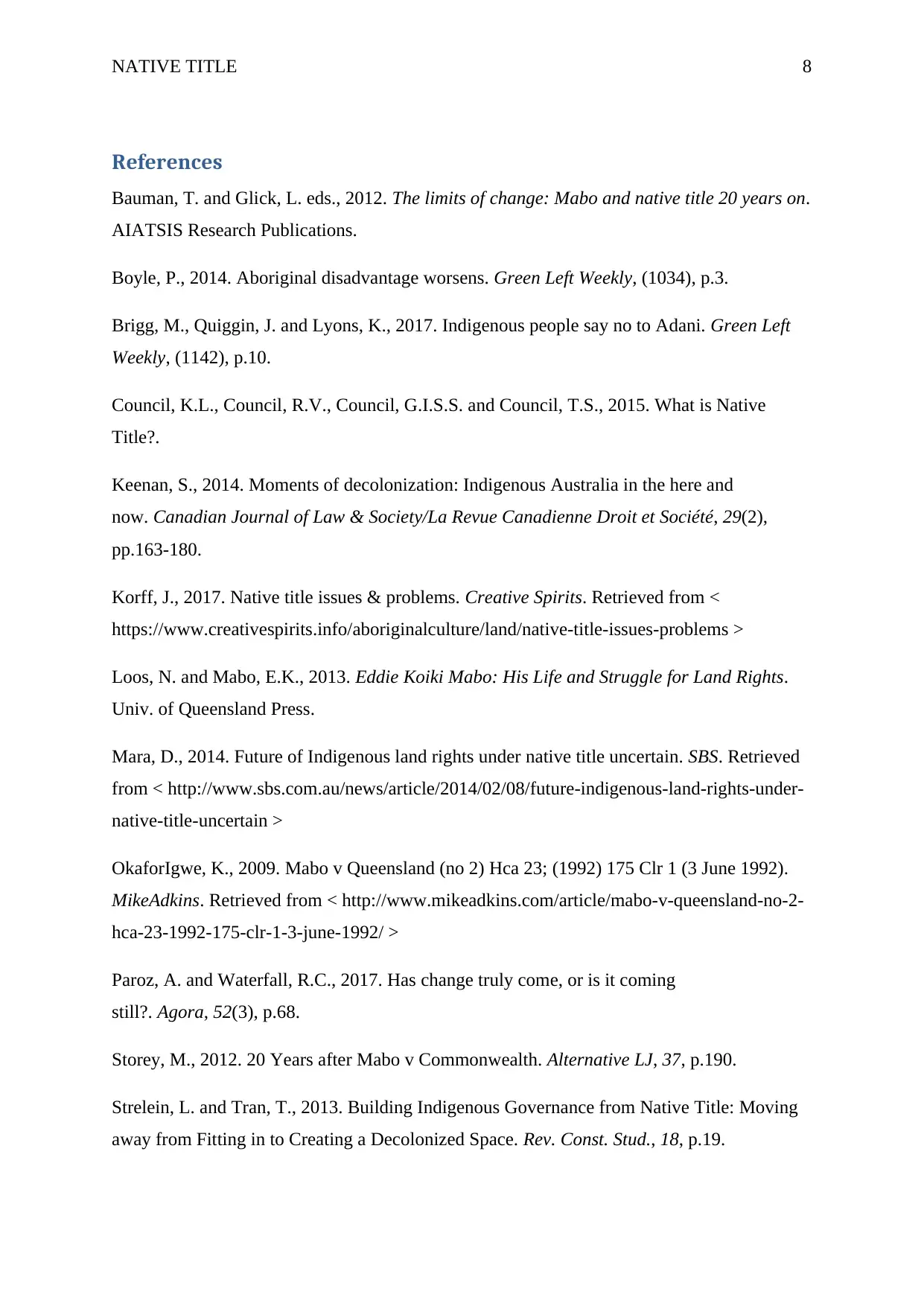
NATIVE TITLE 8
References
Bauman, T. and Glick, L. eds., 2012. The limits of change: Mabo and native title 20 years on.
AIATSIS Research Publications.
Boyle, P., 2014. Aboriginal disadvantage worsens. Green Left Weekly, (1034), p.3.
Brigg, M., Quiggin, J. and Lyons, K., 2017. Indigenous people say no to Adani. Green Left
Weekly, (1142), p.10.
Council, K.L., Council, R.V., Council, G.I.S.S. and Council, T.S., 2015. What is Native
Title?.
Keenan, S., 2014. Moments of decolonization: Indigenous Australia in the here and
now. Canadian Journal of Law & Society/La Revue Canadienne Droit et Société, 29(2),
pp.163-180.
Korff, J., 2017. Native title issues & problems. Creative Spirits. Retrieved from <
https://www.creativespirits.info/aboriginalculture/land/native-title-issues-problems >
Loos, N. and Mabo, E.K., 2013. Eddie Koiki Mabo: His Life and Struggle for Land Rights.
Univ. of Queensland Press.
Mara, D., 2014. Future of Indigenous land rights under native title uncertain. SBS. Retrieved
from < http://www.sbs.com.au/news/article/2014/02/08/future-indigenous-land-rights-under-
native-title-uncertain >
OkaforIgwe, K., 2009. Mabo v Queensland (no 2) Hca 23; (1992) 175 Clr 1 (3 June 1992).
MikeAdkins. Retrieved from < http://www.mikeadkins.com/article/mabo-v-queensland-no-2-
hca-23-1992-175-clr-1-3-june-1992/ >
Paroz, A. and Waterfall, R.C., 2017. Has change truly come, or is it coming
still?. Agora, 52(3), p.68.
Storey, M., 2012. 20 Years after Mabo v Commonwealth. Alternative LJ, 37, p.190.
Strelein, L. and Tran, T., 2013. Building Indigenous Governance from Native Title: Moving
away from Fitting in to Creating a Decolonized Space. Rev. Const. Stud., 18, p.19.
References
Bauman, T. and Glick, L. eds., 2012. The limits of change: Mabo and native title 20 years on.
AIATSIS Research Publications.
Boyle, P., 2014. Aboriginal disadvantage worsens. Green Left Weekly, (1034), p.3.
Brigg, M., Quiggin, J. and Lyons, K., 2017. Indigenous people say no to Adani. Green Left
Weekly, (1142), p.10.
Council, K.L., Council, R.V., Council, G.I.S.S. and Council, T.S., 2015. What is Native
Title?.
Keenan, S., 2014. Moments of decolonization: Indigenous Australia in the here and
now. Canadian Journal of Law & Society/La Revue Canadienne Droit et Société, 29(2),
pp.163-180.
Korff, J., 2017. Native title issues & problems. Creative Spirits. Retrieved from <
https://www.creativespirits.info/aboriginalculture/land/native-title-issues-problems >
Loos, N. and Mabo, E.K., 2013. Eddie Koiki Mabo: His Life and Struggle for Land Rights.
Univ. of Queensland Press.
Mara, D., 2014. Future of Indigenous land rights under native title uncertain. SBS. Retrieved
from < http://www.sbs.com.au/news/article/2014/02/08/future-indigenous-land-rights-under-
native-title-uncertain >
OkaforIgwe, K., 2009. Mabo v Queensland (no 2) Hca 23; (1992) 175 Clr 1 (3 June 1992).
MikeAdkins. Retrieved from < http://www.mikeadkins.com/article/mabo-v-queensland-no-2-
hca-23-1992-175-clr-1-3-june-1992/ >
Paroz, A. and Waterfall, R.C., 2017. Has change truly come, or is it coming
still?. Agora, 52(3), p.68.
Storey, M., 2012. 20 Years after Mabo v Commonwealth. Alternative LJ, 37, p.190.
Strelein, L. and Tran, T., 2013. Building Indigenous Governance from Native Title: Moving
away from Fitting in to Creating a Decolonized Space. Rev. Const. Stud., 18, p.19.
⊘ This is a preview!⊘
Do you want full access?
Subscribe today to unlock all pages.

Trusted by 1+ million students worldwide

NATIVE TITLE 9
Wetherall, C., 2013. The future of Native Title. The Age. Retrieved from <
http://www.theage.com.au/national/education/voice/the-future-of-native-title-20130902-
2t0ns.html >
Wetherall, C., 2013. The future of Native Title. The Age. Retrieved from <
http://www.theage.com.au/national/education/voice/the-future-of-native-title-20130902-
2t0ns.html >
1 out of 10
Related Documents
Your All-in-One AI-Powered Toolkit for Academic Success.
+13062052269
info@desklib.com
Available 24*7 on WhatsApp / Email
![[object Object]](/_next/static/media/star-bottom.7253800d.svg)
Unlock your academic potential
Copyright © 2020–2025 A2Z Services. All Rights Reserved. Developed and managed by ZUCOL.




